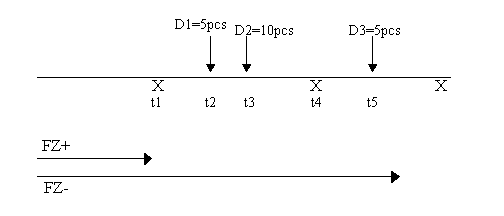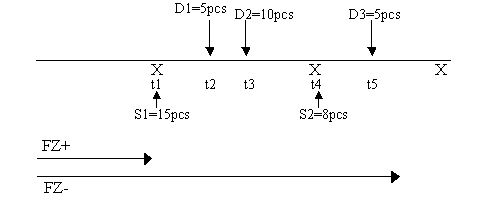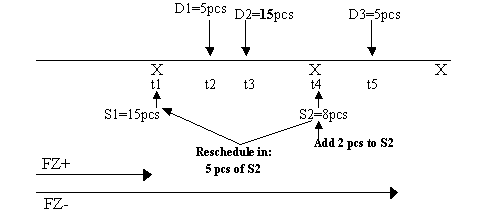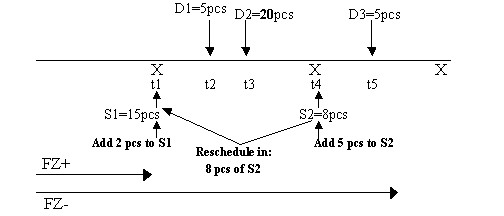Purchase schedules and Enterprise PlanningIn LN, the purchase of JIT items is handled through purchase schedules. This topic describes how Enterprise Planning handles the purchase planning of these items. During an order simulation in Enterprise Planning, purchase volumes are usually planned as planned purchase orders. However, LN can also transfer purchase orders to a purchase schedule in the Purchase Control module of Procurement. LN does so, if:
If you run the Generate Order Planning (cprrp1210m000) session, LN determines whether a shortage exists for a particular item for the simulated time period, and takes into account the demand, the firm supply, and for what exact moments possible shortages exist. If a shortage occurs, LN generates supply. If LN uses a purchase schedule to plan supply for an item, LN does not generate planned purchase orders, but stores a purchase volume in an internal memory. When LN generated all the required purchase volumes for the item, LN groups the ordered purchase volumes in between two delivery moments in one purchase-schedule line, and lot sizes the purchase volumes according to the lot-size rules. General constraints During an order-based planning run, LN checks if shortages exist for the purchase schedule items. If so, LN records the supply of these items in schedule lines that it set on the delivery moments that you generated in the Generate Planned Delivery Moments (tdipu0225m000) session for the supplier involved in the purchase schedule. If the purchase schedule is shipment-based LN lists these planned delivery moments in the Planned Delivery Moments (Shipment Based) (tdipu0125m000) session; if the purchase schedule is receipt based, LN lists the planned delivery moments in the Planned Delivery Moments (Receipt Based) (tdipu0126m000) session. In the order-based planning process, LN carries out a rescheduling step to match supply with demand. The way in which this rescheduling mechanism works for purchase scheduled items differs slightly from the way LN applies this mechanism for items that are not planned through purchase schedules. The following constraints apply for purchase schedule items:
Horizons and Frozen Zones LN uses a specific horizon and a frozen zone to plan purchase schedule items. The horizon end date of a purchase schedule is the date until which LN displays delivery moments in the Planned Delivery Moments (Shipment Based) (tdipu0125m000) session or the Planned Delivery Moments (Receipt Based) (tdipu0126m000) session. LN groups all the requirements between two delivery moments into one purchase schedule. LN groups purchase volumes that fall between the last defined delivery moment and the horizon end date to a schedule line for the last delivery moment. Beyond the horizon end date, where no predefined delivery moments exist, LN inserts required purchase volumes into the purchase schedule, but does not lotsize, nor group the purchase volumes to a delivery moment. After the contract related to the purchase schedule expires, LN translates the required purchase volumes to planned purchase orders for an empty supplier and generates a signal to inform the planner. Beyond the horizon end date, where no predefined delivery moments exist, LN translates required purchase volumes into planned purchase orders for an empty supplier and generates a exception message to warn the planner. For plan items, LN uses a time fence as a period during which LN cannot modify the supply plan and the planned orders. However, for the firm part of purchase schedule items, LN uses a:
Purchase schedule items and time fences In addition to the frozen zone-, the frozen zone+, and the frozen period, you can set a time fence in the Items - Planning (cprpd1100m000) session for items for which the Purchase Schedule in Use check box in the Items - General (tcibd0501m000) session is selected. Although the use of a time fence for purchase schedule items leads to complex and unclear results, the reason for this functionality is that you can have multiple sources for a plan item. You can have several clusters for an item - each with a different cluster. Possibly, only one of these items has a purchase schedule, while the other items are distributed or manufactured items. Therefore, you can enter a time fence for plan items with a purchase schedule. However, if you do enter a time fence, LN displays a warning. Note You cannot use purchase schedules for project items, or for distribution items (items with the cluster segment filled). Note You cannot set capacity constraints in Enterprise Planning for purchase schedule items, because purchase schedules already contain capacity. Therefore, the capacity constraints fields in the Item - Purchase Business Partner (tdipu0110m000) session are disabled for purchase schedule items. Note You can use a sourcing strategy and/or a supply strategy for purchase schedule items. If you use a supplying strategy, supply can entirely or partly be planned based on purchase schedules. Example frozen zone and horizon ![[...]](../images/tr_graph_000078a.gif)
In Figure 1-1, the time span of the purchase schedule is divided in four periods. The figures show how both Procurement, and Enterprise Planning model the existing situation, and how LN handles requirements that occur in Enterprise Planning:
Example planning and rescheduling Figure 1-2 shows the existing demand for a purchase schedule item. All the time moments are in the frozen zone-, and t1 falls after the frozen zone+. In addition the following is true:
 1-2 Planning and rescheduling purchase schedule
items
LN must fill the demand placed on t2 and t3 in time, which is why LN generates supply of 15 pieces on t1, that is, the closest planned delivery moment available. LN must fill the second demand of 5 pieces, placed on t5, with a supply of 8 pcs (minimum lot size) on planned delivery moment t4 (see Figure 1-3).  1-3 Planning supply for a purchase schedule item
Figure 1-4 shows how LN reacts if the demand placed on t3 increases with 5 pieces.  1-4 Rescheduling supply for a purchase schedule
item LN carries out the following steps during an order-based planning run, if the demand placed on t3 increases by five pieces (see Figure 1-3):
Figure 1-5 shows the way in which LN reacts if the demand placed on t3 increases by ten pieces.  1-5 Rescheduling supply for a purchase schedule
item LN carries out the folowing steps during an order-based planning run, if the demand placed on t3 increases with 10 pieces (see Figure 1-5):
Note If Enterprise Planning cannot update the purchase schedule, it generates a planned purchase order for the same supplier. Note that Enterprise Planning blocks planned purchase orders for purchase schedule items at the moment of transferring planned orders to the execution level.
| |||||||||||||||||||||||||||||||